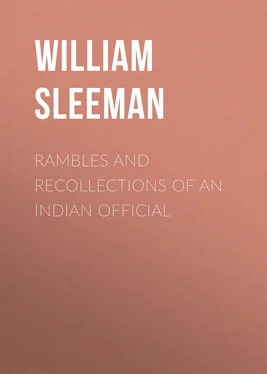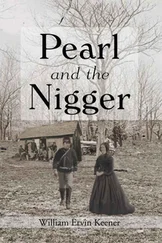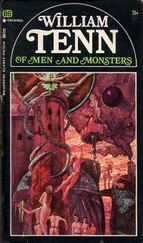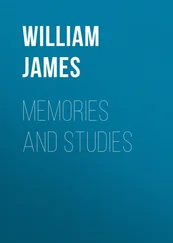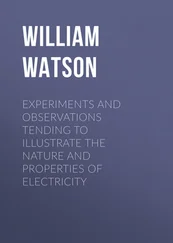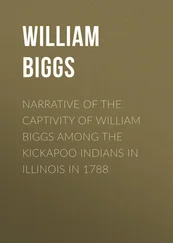William Sleeman - Rambles and Recollections of an Indian Official
Здесь есть возможность читать онлайн «William Sleeman - Rambles and Recollections of an Indian Official» — ознакомительный отрывок электронной книги совершенно бесплатно, а после прочтения отрывка купить полную версию. В некоторых случаях можно слушать аудио, скачать через торрент в формате fb2 и присутствует краткое содержание. Жанр: Путешествия и география, История, foreign_edu, foreign_antique, foreign_prose, на английском языке. Описание произведения, (предисловие) а так же отзывы посетителей доступны на портале библиотеки ЛибКат.
- Название:Rambles and Recollections of an Indian Official
- Автор:
- Жанр:
- Год:неизвестен
- ISBN:нет данных
- Рейтинг книги:4 / 5. Голосов: 1
-
Избранное:Добавить в избранное
- Отзывы:
-
Ваша оценка:
- 80
- 1
- 2
- 3
- 4
- 5
Rambles and Recollections of an Indian Official: краткое содержание, описание и аннотация
Предлагаем к чтению аннотацию, описание, краткое содержание или предисловие (зависит от того, что написал сам автор книги «Rambles and Recollections of an Indian Official»). Если вы не нашли необходимую информацию о книге — напишите в комментариях, мы постараемся отыскать её.
Rambles and Recollections of an Indian Official — читать онлайн ознакомительный отрывок
Ниже представлен текст книги, разбитый по страницам. Система сохранения места последней прочитанной страницы, позволяет с удобством читать онлайн бесплатно книгу «Rambles and Recollections of an Indian Official», без необходимости каждый раз заново искать на чём Вы остановились. Поставьте закладку, и сможете в любой момент перейти на страницу, на которой закончили чтение.
Интервал:
Закладка:
212
One of the tent-pitchers one morning, after pitching our tent, asked the loan of a small extra one for the use of his wife, who was about to be confined. The basket-maker's wife of the village near which we were encamped was called; and the poor woman, before we had finished our breakfast, gave birth to a daughter. The charge is half a rupee, or one shilling for a boy, and a quarter, or sixpence, for a girl. The tent-pitcher gave her ninepence, which the poor midwife thought very handsome, The mother had come fourteen miles upon a loaded cart over rough roads the night before; and went the same distance with her child the night after, upon the same cart. The first midwife in Europe could not have done her duty better than this poor basket-maker's wife did hers. [W. H. S.]
213
The 'present case' was of a medical, not a surgical, nature.
214
The Hindoo practitioners are called 'baid' (Sanskrit 'vaidya', followers of the Veda, that is to say, the Ayur Veda). The Musalmān practitioners are generally called 'hakīm'. The Egyptian school (Misrānī, Misrī, or Suryānī, that is, Syrian) never practise bleeding, and are partial to the use of metallic oxides. The Yunānī physicians approve of bleeding, and prefer vegetable drugs. The older writers on India fancied that the Hindoo system of medicine was of enormous antiquity, and that the principles of Galenical medical science were ultimately derived from India. Modern investigation has proved that Hindoo medicine, like Hindoo astronomy, is largely of Greek origin. This conclusion has been expressed in an exaggerated form by some writers, but its general truth appears to be established. The Hindoo books treating of medicine are certainly older than Wilson supposed, for the Bower manuscript, written in the second half of the fourth century of our era, contains three Sanskrit medical treatises. The writers had, however, plenty of time to borrow from Galen, who lived in the second century. The Indian aversion to European medicine, as distinguished from surgery, still exists, though in a degree somewhat less than in the author's time. Many municipal boards have insisted on employing 'baids' and 'hakīms' in addition to the practitioners trained in European methods. Well-to-do patients often delay resort to the English physician until they have exhausted all resources of the 'hakīm' and have been nearly killed by his drastic treatment. One medical innovation, the use of quinine as a febrifuge, has secured universal approbation. I never heard of an Indian who disbelieved in quinine. Chlorodyne also is fully appreciated, but most of the European medicines are regarded with little faith.
Since the author wrote, great progress has been made in providing hospital and dispensary accommodation. Each 'district', or unit of civil administration, has a fairly well equipped combined hospital and dispensary at head-quarters, and branch dispensaries exist in almost every district. An Inspector-General of Dispensaries supervises the medical administration of each province, and medical schools have been organized at Calcutta, Madras, Bombay, Lahore, and Agra. During Lord Dufferin's Viceroyalty and afterwards, energetic steps were taken to improve the system of medical relief for females. Pandit Madhusadan Gupta, on January 10, 1836, was the first Hindoo who ventured to dissect a human body and teach anatomy. India can now boast of a considerable number of Hindoo and Musalmān practitioners, trained in European methods, and skilful in their profession. Much has been done, infinitely more remains to be done. Details will be found in I.G. (1907), vol. iv, chap. 14, 'Medical Administration', The article 'Medicine' in Balfour, Cyclopaedia , 3rd ed., 1885, on which I have drawn for some of the facts above stated, gives a good summary of the earlier history of medicine in India, but greatly exaggerates the antiquity of the Hindoo books. On this question Weber's paper, 'Die Griechen in Indien' (Berlin, 1890, p. 28), and Dr. Hoernle's remarks on the Bower manuscript (in J.A.S.B. , vol. lx (1891), Part I, p. 145) may be consulted. Dr. Hoernle's annotated edition and translation of the Bower MS. were completed in 1912. Part of the work is reprinted with additions in the Ind. Ant. for 1913 and 1914.
215
December, 1835. The name of the village is spelled Behrole by the author.
216
The Dasān river rises in the Bhopāl State, flows through the Sāgar district of the Central Provinces, and along the southern boundary of the Lalitpur subdivision of the Jhānsī District, United Provinces of Agra and Oudh. It also forms the boundary between the Jhānsī and Hamīrpur Districts, and falls into the Betwa after a course of about 220 miles. The name is often, but erroneously, written Dhasān. It is the Sanskrit Dasārna.
217
This emblem is a lotus, not a rose flower. The latter is never used in Hindoo symbolism. The lotus is a solar emblem, and intimately associated with the worship of Vishnu.
218
It rather indicates that the husband was on horseback when killed. The sculptures on satī pillars often commemorate the mode of death of the husband. Sometimes these pillars are inscribed. They usually face the east. An open hand is often carved in the upper compartment as well as the sun and moon. A drawing of such a pillar will be found in J.A.S.B. , vol. xlvi. Part I, 1877, pl. xiv. A.S.R. , vol. iii, p. 10; vol. vii, p. 137; vol. x, p. 75; and vol. xxi, p. 101, may be consulted.
219
The 'newly-acquired territories' referred to are the Sāgar and Nerbudda Territories, comprising the seven districts, Sāgar, Jubbulpore, Hoshangābād, Seonī, Damoh, Narsinghpur, and Baitūl, ceded in 1818, and now included in the Central Provinces. The tenor of the replies given to Lord Amherst's queries shows how far the process of Hindooizing had advanced among the European officials of the Company. Lord Amherst left India in March, 1828. See ante. Chapter 4 and Chapter 8, for cases of satī (suttees). For a good account of the suttee discussions and legislation, see D. Boulger, Lord William Bentinck (1897), chap. v, in 'Rulers of India' Series. No other biography of Lord William Bentinck exists.
220
Dhamonī is in the Sāgar district of the Central Provinces, about twenty-nine miles north of Sāgar. The fort was taken by General Marshall in 1818. It had been rebuilt by Rājā Bīrsingh Deo of Orchhā on an enormous scale about the end of the sixteenth century. In the original edition, the author's march is said to have taken place 'on the 24th'. This must be a mistake for 'on the 4th'; as the last date, that of the march to Bahrol, was the 3rd December. The author reached Agra on January 1, 1836,
221
The number fifty-two is one of the Hindoo favourite numbers, like seven, twelve, and eighty-four, held sacred for astronomical or astrological reasons. Bīrsingh Deo was the younger brother of Rāmchand, head of the Bundēla clan. To oblige Prince Salīm, afterwards the Emperor Jahāngīr, he murdered Abūl Fazl, the celebrated minister and historian of Akbar, on August 12, 1602, Jahāngīr, after his accession, rewarded the murderer by allowing him to supersede his brother in the headship of his clan, and by appointing him to the rank of 'commander of three thousand'. The capital of Bīrsingh was Orchhā. His successors are often spoken of as Rājās of Tehrī. The murder is fully described in The Emperor Akbar by Count von Noer, translated by A. S. Beveridge, Calcutta, 1890, vol. ii, pp. 384-404. Orchhā is described post , Chapters 22,23.
Читать дальшеИнтервал:
Закладка:
Похожие книги на «Rambles and Recollections of an Indian Official»
Представляем Вашему вниманию похожие книги на «Rambles and Recollections of an Indian Official» списком для выбора. Мы отобрали схожую по названию и смыслу литературу в надежде предоставить читателям больше вариантов отыскать новые, интересные, ещё непрочитанные произведения.
Обсуждение, отзывы о книге «Rambles and Recollections of an Indian Official» и просто собственные мнения читателей. Оставьте ваши комментарии, напишите, что Вы думаете о произведении, его смысле или главных героях. Укажите что конкретно понравилось, а что нет, и почему Вы так считаете.
